It’s a Cascade of 14nm CPUs: AnandTech’s Intel Core i9-10980XE Review
by Dr. Ian Cutress on November 25, 2019 9:00 AM ESTCPU Performance: System Tests
Our System Test section focuses significantly on real-world testing, user experience, with a slight nod to throughput. In this section we cover application loading time, image processing, simple scientific physics, emulation, neural simulation, optimized compute, and 3D model development, with a combination of readily available and custom software. For some of these tests, the bigger suites such as PCMark do cover them (we publish those values in our office section), although multiple perspectives is always beneficial. In all our tests we will explain in-depth what is being tested, and how we are testing.
All of our benchmark results can also be found in our benchmark engine, Bench.
Application Load: GIMP 2.10.4
One of the most important aspects about user experience and workflow is how fast does a system respond. A good test of this is to see how long it takes for an application to load. Most applications these days, when on an SSD, load fairly instantly, however some office tools require asset pre-loading before being available. Most operating systems employ caching as well, so when certain software is loaded repeatedly (web browser, office tools), then can be initialized much quicker.
In our last suite, we tested how long it took to load a large PDF in Adobe Acrobat. Unfortunately this test was a nightmare to program for, and didn’t transfer over to Win10 RS3 easily. In the meantime we discovered an application that can automate this test, and we put it up against GIMP, a popular free open-source online photo editing tool, and the major alternative to Adobe Photoshop. We set it to load a large 50MB design template, and perform the load 10 times with 10 seconds in-between each. Due to caching, the first 3-5 results are often slower than the rest, and time to cache can be inconsistent, we take the average of the last five results to show CPU processing on cached loading.
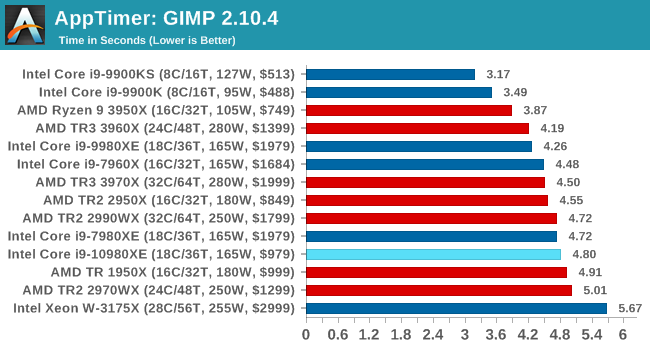
We saw a slight regression here with the 10980XE, which may be down to some of the security updates given that this benchmark tests loading a program which can involve user mode changes.
3D Particle Movement v2.1: Brownian Motion
Our 3DPM test is a custom built benchmark designed to simulate six different particle movement algorithms of points in a 3D space. The algorithms were developed as part of my PhD., and while ultimately perform best on a GPU, provide a good idea on how instruction streams are interpreted by different microarchitectures.
A key part of the algorithms is the random number generation – we use relatively fast generation which ends up implementing dependency chains in the code. The upgrade over the naïve first version of this code solved for false sharing in the caches, a major bottleneck. We are also looking at AVX2 and AVX512 versions of this benchmark for future reviews.
For this test, we run a stock particle set over the six algorithms for 20 seconds apiece, with 10 second pauses, and report the total rate of particle movement, in millions of operations (movements) per second. We have a non-AVX version and an AVX version, with the latter implementing AVX512 and AVX2 where possible.
3DPM v2.1 can be downloaded from our server: 3DPMv2.1.rar (13.0 MB)
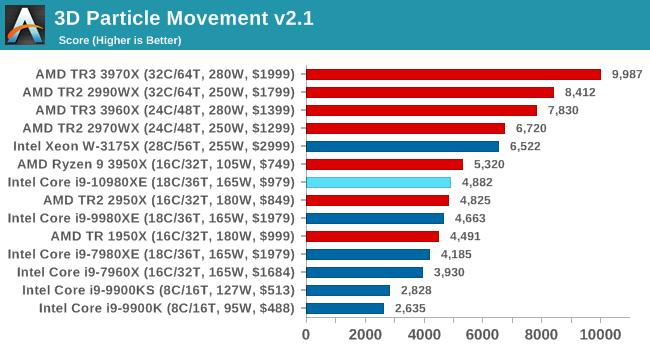
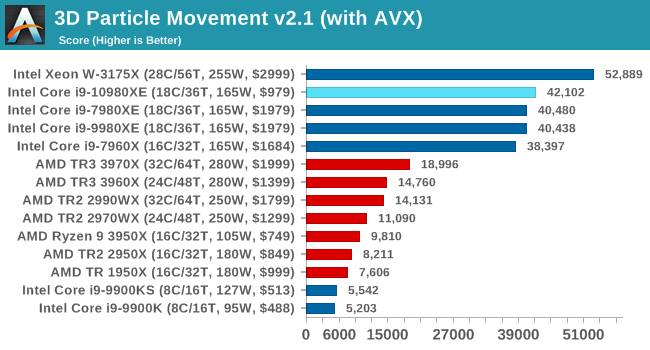
The extra frequency shows a bit here in MT mode, but otherwise equal performance to the 9980XE.
Dolphin 5.0: Console Emulation
One of the popular requested tests in our suite is to do with console emulation. Being able to pick up a game from an older system and run it as expected depends on the overhead of the emulator: it takes a significantly more powerful x86 system to be able to accurately emulate an older non-x86 console, especially if code for that console was made to abuse certain physical bugs in the hardware.
For our test, we use the popular Dolphin emulation software, and run a compute project through it to determine how close to a standard console system our processors can emulate. In this test, a Nintendo Wii would take around 1050 seconds.
The latest version of Dolphin can be downloaded from https://dolphin-emu.org/
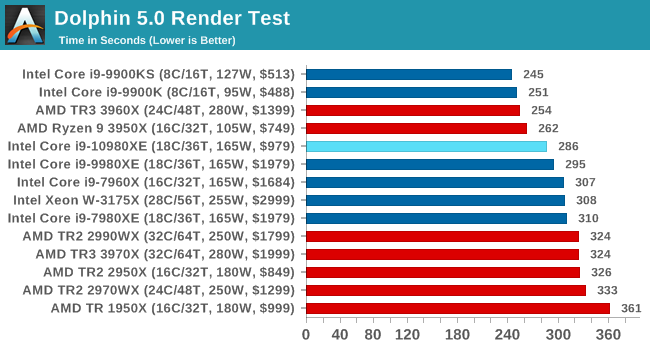
DigiCortex 1.20: Sea Slug Brain Simulation
This benchmark was originally designed for simulation and visualization of neuron and synapse activity, as is commonly found in the brain. The software comes with a variety of benchmark modes, and we take the small benchmark which runs a 32k neuron / 1.8B synapse simulation, equivalent to a Sea Slug.
Example of a 2.1B neuron simulation
We report the results as the ability to simulate the data as a fraction of real-time, so anything above a ‘one’ is suitable for real-time work. Out of the two modes, a ‘non-firing’ mode which is DRAM heavy and a ‘firing’ mode which has CPU work, we choose the latter. Despite this, the benchmark is still affected by DRAM speed a fair amount.
DigiCortex can be downloaded from http://www.digicortex.net/
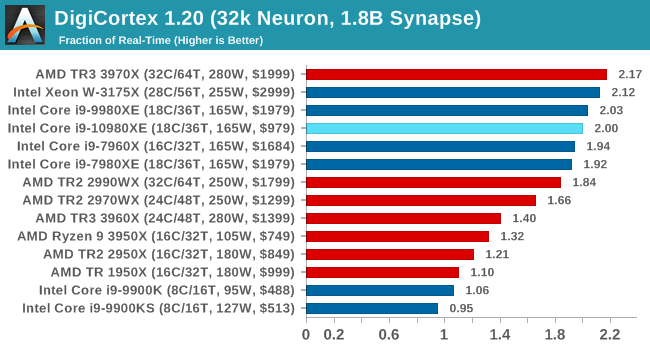
y-Cruncher v0.7.6: Microarchitecture Optimized Compute
I’ve known about y-Cruncher for a while, as a tool to help compute various mathematical constants, but it wasn’t until I began talking with its developer, Alex Yee, a researcher from NWU and now software optimization developer, that I realized that he has optimized the software like crazy to get the best performance. Naturally, any simulation that can take 20+ days can benefit from a 1% performance increase! Alex started y-cruncher as a high-school project, but it is now at a state where Alex is keeping it up to date to take advantage of the latest instruction sets before they are even made available in hardware.
For our test we run y-cruncher v0.7.6 through all the different optimized variants of the binary, single threaded and multi-threaded, including the AVX-512 optimized binaries. The test is to calculate 250m digits of Pi, and we use the single threaded and multi-threaded versions of this test.
Users can download y-cruncher from Alex’s website: http://www.numberworld.org/y-cruncher/

Agisoft Photoscan 1.3.3: 2D Image to 3D Model Conversion
One of the ISVs that we have worked with for a number of years is Agisoft, who develop software called PhotoScan that transforms a number of 2D images into a 3D model. This is an important tool in model development and archiving, and relies on a number of single threaded and multi-threaded algorithms to go from one side of the computation to the other.
In our test, we take v1.3.3 of the software with a good sized data set of 84 x 18 megapixel photos and push it through a reasonably fast variant of the algorithms, but is still more stringent than our 2017 test. We report the total time to complete the process.
Agisoft’s Photoscan website can be found here: http://www.agisoft.com/
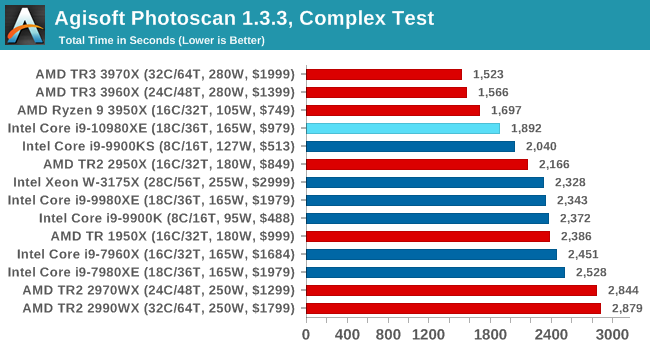
The 10980XE here becomes the fastest Intel CPU we've tested on Photoscal, with a sizeable uplift over the 9980XE. This is likely due to the faster memory.












79 Comments
View All Comments
milkywayer - Monday, November 25, 2019 - link
Thank you AMD for strong arming the serial-milker Intel. Price cut from $1900 to $900. Hard to believe Intel would cut down on the core count milking. Am I dreaming?regsEx - Monday, November 25, 2019 - link
Mind it was Intel and without any competition who lowered mainstream price from $500 to $300 back in 2011. 3700X would cost $500 now if not that. So thank you, Intel.Spunjji - Monday, November 25, 2019 - link
Balderdash. Near the end of 2010 you could get a 6-core AMD Phenom II CPU for $270. By 2011, an "8 core" 4-module Bulldozer cost the same and Intel's products were priced to compete with that.So, uh, thanks again AMD..?
karmapop - Monday, November 25, 2019 - link
Sorry, but you may want to dig back into the review archives for some untinted perspective on that info. In fact, you're both incorrect. That mainstream performance pricing shift happened in 2008, with the introduction of the Yorkfield Core 2 Quad chips, and more importantly the Bloomfield Core i7 (with the i7-920 becoming that $300 darling entry point for the enthusiast platform).Those mid-2010 Thuban Phenom II X6 chips? Passably competitive with the lowest end quad-core Bloomfield chips (which were already on the market for a year and a half prior). And let's just forget about the dumpster fire that was Bulldozer, given that fabled FX-8150 had trouble matching the old Thuban Phenom II X6 at launch.
nt300 - Tuesday, November 26, 2019 - link
The FX 8350 & FX 8320 Piledriver CPUs saved AMDs bacon and proved to be more than enough for modern PC Gaming back in the day. They held great price/performance and were highly cost effective. Among Steamroller, then Excavator for the APU markets, they've held AMD afloat just in time for the superior ZEN launch. Now sit back and watch Intel finally struggle, deservingly so.yeeeeman - Wednesday, November 27, 2019 - link
They were so crap that AMD could boast 50% better ipc with zen over bulldozer, while still being lower than Skylake.Korguz - Wednesday, November 27, 2019 - link
too bad zen has better ipc then intel now...Gondalf - Wednesday, November 27, 2019 - link
According to the official Spec submissions nope, Zen 2 is on pair with Skylake (bypassing the huge L3). More or less AMD enlarged the L3 just to have the lead, this have a cost obviously, the 7nm silicon is pretty expensive. Try to image a 9900K with 32MB of L3 with the same latency.You will have a winner.
Korguz - Wednesday, November 27, 2019 - link
gondalfsorry but zen 2 does have better ipc then intel does now.. why else does intel need such high clocks to compete with lower clocked chips ?? explain that one.. clock for clock.. zen 2.. has better ipc...
Qasar - Wednesday, November 27, 2019 - link
gondalf : According to the official Spec submissions " what spec submissions page ? also.. if you think having a large L3 cache is the reason why zen has more ipc then intel, then there is something wrong. if that was the case, WHY didnt intel do the same with the 10xxx series they just released ? keep in mind, 10xxx series, as 10 megs more of L2 to play around with... lets see you explain that as well.